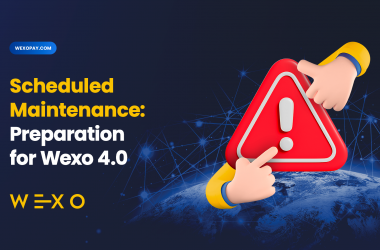Proof-of-Work vs Proof-of-Stake: Dilemma of the cryptocurrency's world
ERC-20 ETHEREUM (ETH) CRYPTOCURRENCY MINING PoS (Proof-of-Stake) PoW (Proof-of-Work)16-Mar-2022

TOP-Beiträge

New Wexo Cashback App: More than cashback
Wexo launches a new generation of its Cashback app – a modern platform where you earn real value in Bitcoin, gold,...
Mehr lesen
Wexo 4.0 Is Coming: What to Expect from the Scheduled Maintenan...
We’re getting ready to launch Wexo 4.0 with a major infrastructure upgrade. Learn what’s changing, why a new passwo...
Mehr lesen
Deflation in Action: 3,541,053 WEXO Tokens Burned
The fifth burn round has permanently removed over 3.5 million WEXO tokens from circulation. Learn what this means f...
Mehr lesenThe blockchain technology advantages are nothing new, and its transparent transactions with trusted security are its most significant forte. This transaction verification system operates through a network consensus without the supervision of any central authority.
As a result, all participants in the network can agree on what is or is not true when creating new blocks in a ledger. Today, we know of several networks with different chaining methods, but the best known are "Proof-of-Work" (PoW) and "Proof-of-Stake" (PoS). However, what is the difference between them, and which block creation method is better?
What is Proof-of-Work?
Proof-of-Work is a mechanism first used by establishing Bitcoin, the world's largest cryptocurrency. The network participants compete to be the one who closes the block by inserting the correct "nonce" code and thus gets the right to create a new block.
Finding and implementing the correct code requires many computing techniques that consume a lot of electricity. After entering the number, other miners have only to verify the correctness of the nonce; and a new block opens. Each miner guards the other; in other words, they keep an eye on each other to prevent the formation of false blocks.
What is a Proof-of-Stake?
Proof-of-Stake appeared as a solution to a problem caused by excessive power consumption generated by the PoW method. In 2011, an anonymous called QuantumMechanic came up with this alternative solution of network consensus to eliminate the computing power costs during mining. The system randomly selects one validator to check the validity of all transactions in the block.
The selected network participant must guarantee that his/her coins are held in a safe deposit to examine given data. If other validators find a false verification, it will destroy the validator's coins. However, this system applies only if a given block's fee amount is less than the stake value.
So which mechanism is better?
Both PoW and PoS are designed to help nodes in the blockchain network verify all transactions that occur. When the nodes agree on the validity of the transactions block, the data are added to the blockchain network. Both models offer characteristic methods for achieving the same result.
PoS supporters
PoS creators can experiment more with block selection methodologies and penalty behaviour in the network. In addition, there may be a much larger number of PoS networks because they all use a different native token or resource to secure.
All PoW blockchains compete for a limited power source (electricity in the real world), which severely limits the number of PoW blockchains that could be supported. This means that the PoS algorithm can be used simultaneously by many different ecosystems with different ideologies.
Fast and low-cost transactions are popular among communities built on cryptocurrencies with the PoS mechanism. Networks with this mechanism verify one block in a matter of seconds. By comparison, PoW on the BTC network verifies one block of transactions in about 10 minutes and consumes a lot of electricity.
PoS Critics
The Proof-of-Work model consumes much more energy than the Proof-of-Stake algorithm; as the complexity of the network grows, more and more computing power is needed to resolve the code. These are the operating costs on a highly secure network, in which data are connected to a verified history of human choices. This data cannot deceive the system that proves every single transaction.
By cryptocurrencies using the PoS model, concerns have been raised about a possible attack if an individual or group could collect more than 51% of the total volume of coins in the system. This would lead to an approval of transactions that had never occurred in the system. Some smaller networks with the PoW algorithm verification method experienced a similar problem. However, there are already several suggestions on avoiding this threat. Especially in some PoS networks, the community can coordinate a "hard fork" and clear the deposits of validators who would attempt such an attack.
Another problem that PoS critics have pointed out is the absence of real-world input. Proof-of-Work proponents use real-world energy, meaningfully adding value to the mined-out blocks. By eliminating the electricity costs that arise during mining, validators are rewarded only for the guarantee by digital currency already existing in the network. This can devalue the currency.
The demotivation of network users to use a given cryptocurrency as a payment stands out as the last PoS algorithm´s problem. Vice-versa, validators are encouraged to keep, accumulate, and not use coins. It leads to cryptocurrency centralization and increases the risk associated with security.
PoW is a proven system on the Bitcoin network that has not been hacked since its inception in 2009. Its alternative is relatively new to the market and is still in the early stages of its adaptation and implementation.
Advantages
- Energy efficient
- It does not require an expensive computing technique
- Fast and cheap transactions
Disadvantages
- Less secure than Proof-of-Work
- Validators with more coins have a significant impact on the transactions´ verification.
- Being unable to dispose of coins at the time of staking and thus be less flexible in using coins.
Summary
The network consensus mechanism is important for maintaining the integrity of the decentralized network and its ecosystem. Proof-of-Work is energy-intensive, while Proof-of-Stake can have several security complications. However, there are currently some blockchain ecosystems with different algorithms in the cryptocurrency market. Only time will show which mechanism is best for maintaining three main blockchain features - decentralization, security and scalability. Perhaps, it will not be any of the candidates mentioned above but a newly formed crypto-community darling, the Proof-of-Authority (POA).
